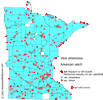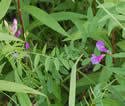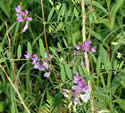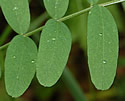Vicia americana (American Vetch)
| Also known as: | Purple Vetch |
|---|---|
| Genus: | Vicia |
| Family: | Fabaceae (Pea) |
| Life cycle: | perennial |
| Origin: | native |
| Habitat: | part shade, sun; fields, prairies, open woods, thickets, along roads |
| Bloom season: | May - September |
| Plant height: | 1 to 3 foot vine |
| Wetland Indicator Status: | GP: FACU MW: FACU NCNE: FACU |
| MN county distribution (click map to enlarge): |  |
| National distribution (click map to enlarge): |  |
Pick an image for a larger view. See the glossary for icon descriptions.
Detailed Information
Flower: 

![[photo of flowers]](/udata/r9ndp23q/pd/vicia-americana-10-13-t.jpg) 2 to 9 flowers in loose clusters (racemes) arising from leaf axils in the upper part of the stem. Individual flowers are a typical shape for a member of the pea family, slightly elongated, ½ to ¾ inch long. Flower color ranges from pink to purple to blue. The calyx holding the flower is hairless to minutely hairy, with 5 broadly triangular lobes, the lower lobes up to twice as long as the short upper lobes, and all rather shorter than the calyx tube. Flower stalks are minutely hairy.
2 to 9 flowers in loose clusters (racemes) arising from leaf axils in the upper part of the stem. Individual flowers are a typical shape for a member of the pea family, slightly elongated, ½ to ¾ inch long. Flower color ranges from pink to purple to blue. The calyx holding the flower is hairless to minutely hairy, with 5 broadly triangular lobes, the lower lobes up to twice as long as the short upper lobes, and all rather shorter than the calyx tube. Flower stalks are minutely hairy.
Leaves and stem: 

![[photo of leaves]](/udata/r9ndp23q/purple/american-vetch_0608_121842-t.jpg) Leaves are compound with 4 to 8 pairs of leaflets and a tendril at the end of the leaf that winds around other plants for support. At the base of the stalk is a pair of leafy appendages (stipules) that are up to 1/3 inch long, sharply pointed at both ends, with 3 sharp teeth in the lower half. Leaflets are narrowly egg-shaped to oblong-elliptic and may have rounded, blunt or pointed tips. Each is up to 1½ inch long and about ¼ inch wide, toothless and hairless, becoming smaller towards the end of the leaf. Stems are angled, hairless, and branched.
Leaves are compound with 4 to 8 pairs of leaflets and a tendril at the end of the leaf that winds around other plants for support. At the base of the stalk is a pair of leafy appendages (stipules) that are up to 1/3 inch long, sharply pointed at both ends, with 3 sharp teeth in the lower half. Leaflets are narrowly egg-shaped to oblong-elliptic and may have rounded, blunt or pointed tips. Each is up to 1½ inch long and about ¼ inch wide, toothless and hairless, becoming smaller towards the end of the leaf. Stems are angled, hairless, and branched.
Fruit: 
![[photo of fruit]](/udata/r9ndp23q/purple/american-vetch_0620_101538-t.jpg) Fruit is a pea-shaped pod, about 1 inch long, that turns from green to reddish brown as the fruit ripens. Pods contain an average of 10 seeds.
Fruit is a pea-shaped pod, about 1 inch long, that turns from green to reddish brown as the fruit ripens. Pods contain an average of 10 seeds.
Notes:
There are several members of the pea family that are climbing vines with racemes of purplish or pinkish flowers. One major distinguishing feature is the stipule at the base of the leaf stalk, which is unique for many species; American Vetch is unique with the 3 sharp teeth on the lower half of the stipule. The non-native vining vetches tend to create dense, tangled masses where American Vetch is more spindly, with fewer flowers in looser clusters. When not in bloom, American Vetch plants with rounded leaflets might be mistaken for Crown Vetch (Coronilla varia), but Crown Vetch has no tendril at the end and its stems are leafier, plus Crown Vetch has round flower clusters.
There are 3 recognized subspecies (or vars, depending on the reference) of Vicia americana, 2 of which are found in Minnesota, though most herbarium records are not identified to a specific subspecies/var: subsp. americana is likely widespread, subsp. minor is likely less common. The differences between the two are not well documented but minor may have thick, proportionately narrower leaflets that are oblong-elliptic, and 4 or fewer flowers per cluster, with subsp. americana having broader, thin leaflets that are more lance-elliptic to egg-shaped, and 4 or more flowers per cluster. From some subsp. minor herbarium records I've examined, the lower leaves may be as described and the upper leaves more like subsp. americana, so check the whole plant before deciding which one you might have.
Native Plant Nurseries, Restoration and Landscaping Services ↓
More photos
 American Vetch plant
American Vetch plant American Vetch plant
American Vetch plant American Vetch plant
American Vetch plant a plant with blue-ish flowers
a plant with blue-ish flowers leaf with rounded leaflets
leaf with rounded leaflets
Photos by K. Chayka taken in Ramsey County. Other photos courtesy Peter M. Dziuk.
Comments
Have you seen this plant in Minnesota, or have any other comments about it?
on: 2009-07-01 20:47:54
I found the american vetch on the side of the road in White Bear Lake by Bald eagle lake. I noticed the stunning flowers (a whole field) and picked a section to identify it. Your website says 4 to eight leave pairs this section had 7.
on: 2009-07-01 22:37:43
Unless it's your own property I recommend you take pictures of wildflowers you want to identify later, rather than pick them. You don't know if you're taking something harmful, or causing harm to the habitat. Besides, you could be fined if you're caught taking flowers from public lands.
on: 2011-06-16 22:05:27
Have several of these on the perimeter of my backyard. Couldn't identify it with Wildflowers of Minnesota Field Guide. Had to come to this website.
on: 2011-06-19 12:17:31
It has been blooming all around our wooded area for the past week or so. I do not recall this many in years past. I hope it chokes out the non-native Candada vetch of which I am having difficulty in controlling.
on: 2013-07-15 15:45:41
Hi Sue Are you by chance referring to the Canadian Milkvetch (astragalus canadensis)? If so, just know that it is also a native plant, and has value as a nitragen fixer, soil stabilizer and resource for wild pollinators; especially bumble bees(much like the American vetch).
on: 2014-06-26 20:36:49
Blooming along the roadside near Little Boy Lake in Longville Minnesota the week of June 9th.
on: 2015-07-21 23:07:54
Our driveway ends at the Pine county/Kanabec county line. We have these growing in our front yard near the road. They remind me of the Jacob's Ladder plant.
on: 2019-07-03 12:35:28
First time I've noticed this plant; it is thriving between a swamp and a road.
on: 2020-06-08 15:15:15
I have this on the edge of my forested driveway.
on: 2020-07-02 18:03:18
This is growing in the garden of a house we just bought in town. I've also seen it on one of the trails at the Scenic Overlook in Silver Bay.






